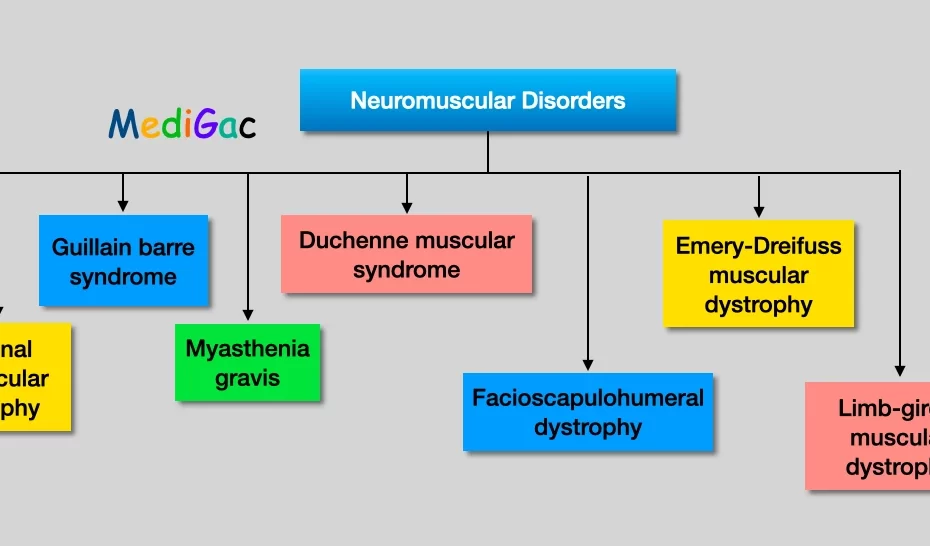We have discussed total of seven neuromuscular disorders and they are :
- Spinal muscular atrophy
- Guillain barre syndrome
- Myasthenia gravis
- Duchenne muscular dystrophy
- FacioScapuloHumeral dystrophy
- Emery-Dreifuss muscular dystrophy
- Limb-Girdle muscular dystrophy
1. Spinal muscular atrophy :
Spinal muscular atrophy (SMA) is a series of hereditary illnesses in which a person’s muscles lose control due to nerve cell loss in the spinal cord and brain stem. It is a form of motor neuron disease and a neurological illness. Muscle loss and weakness are symptoms of spinal muscular atrophy (SMA).
This is an autosomal recessive and mainly occurs due to defect in chromosome 5q.
There are three types of spinal muscular atrophy and they are – Types-I (werdnig hoffman disease), Type-II (Dubowitz disease), Types-III (Kugelberg welander disease)
Presenting clinical features :
- Type – 1 : Floppiness(ragged doll appearance), absence of deep tendon reflexes, sparing of extra ocular muscles, fasciculation of tongue.
- Type-2 : Micorcephaly, small stature, odd faces, and mild to severe mental retardation are all symptoms of mental retardation.
- Types-3 : characterised by muscle atrophy and weakening in the arms and legs, resulting in walking problems and eventual ambulation loss.
2. Guillain barre syndrome :
Guillain-Barré syndrome (GBS) is a rare neurological illness in which the body’s immune system assaults a network of nerves outside of the brain and spinal cord.
This disease is also called as – acquired inflammatory demyelinating polyneuropathy.
Post-infectious neuropathy develops 1-6 weeks after infection with clostridium jejuni of mycoplasma, which causes diarrhoea.
Anti-ganglioside antibodies, such as Anti GM-1 and Anti GD-1, are the most common cause of this condition.
Presenting clinical features :
- Eye muscles and vision are difficult to control.
- Swallowing, speaking, or chewing difficulties.
- Sensations of prickling or pins and needles in the hands and feet.
- Pain that can be excruciating, especially at night.
- Uncertainty and a lack of coordination.
- Heart rate or blood pressure that is abnormal.
3. Myasthenia gravis :
Myasthenia gravis is a neuromuscular condition caused by an autoimmune disease that produces weakening in the skeletal muscles that increases with exercise and improves with rest. These muscles are in charge of breathing and moving various portions of the body, such as the arms and legs.
Antibodies against acetylcholine receptors are to blame, as they bind to receptors and block acetylcholine from binding to them.
Presenting clinical features :
The patient presents with –
- Muscles weakness in skeletal muscle, extra-ocular muscle
- Diurnal
- Getting worse feeling during any activity
4. Duchenne muscular dystrophy :
Duchenne muscular dystrophy (DMD) is a hereditary illness marked by progressive muscle degeneration and weakening caused by mutations in the dystrophin protein, which helps maintain muscle cells intact. Dystrophinopathies are a group of four diseases. DMD is one of them.
This is a X-linked recessive disorder, occurs due to defect in X-chromosome(Xp21) which codes for protein, Dystrophin(This helps to mediate muscle contraction).
Presenting clinical features :
The patient presents with complaints like :
- Feeling delay while walking
- Waddling gait
- Gower’s sign – The Gowers’ sign is a medical indication that suggests proximal muscular weakness, specifically in the lower leg.
- Pseudohypertrphy
5. Facioscapulohumeral dystrophy :
Muscle weakening and wasting are symptoms of facioscapulohumeral muscular dystrophy (FSHD) (atrophy). The muscles that are afflicted in the face (facio), around the shoulder blades (scapule), and in the upper arms (scapula) give the disorder its name (humeral).
This is an autosomal dominant disease.
Presenting clinical features :
- Winging of scapula
- Expressionless face
6. Emery-Dreifuss muscular dystrophy :
Emery-Dreifuss muscular dystrophy is a muscular dystrophy that affects the heart, joints, and muscles. Contractures of the elbows, ankles, and neck are common joint problems that appear in children. Muscle weakness and atrophy are common symptoms in children and adults with this dystrophy.
Presenting clinical features :
- Weakness comes before contracture.
- In the upper limb, proximal muscle groups are damaged.
- In the lower limb, distal muscle groups are damaged.
7. Limb-girdle muscular dystrophy :
Limb-girdle The term muscular dystrophy refers to a set of disorders that cause muscle weakness and atrophy in the arms and legs. The muscles nearest to the body (proximal muscles) are the most impacted, particularly the muscles of the shoulders, upper arms, pelvic area, and thighs.
This can be both autosomal dominant and recessive. And occurs due to defect in sarcomere and calpain-3 protein.
Presenting clinical features :
- Proximal muscles gets more affected than the distal muscles.
- Sparing of muscles like facial, extra-ocular and pharyngeal muscles.
